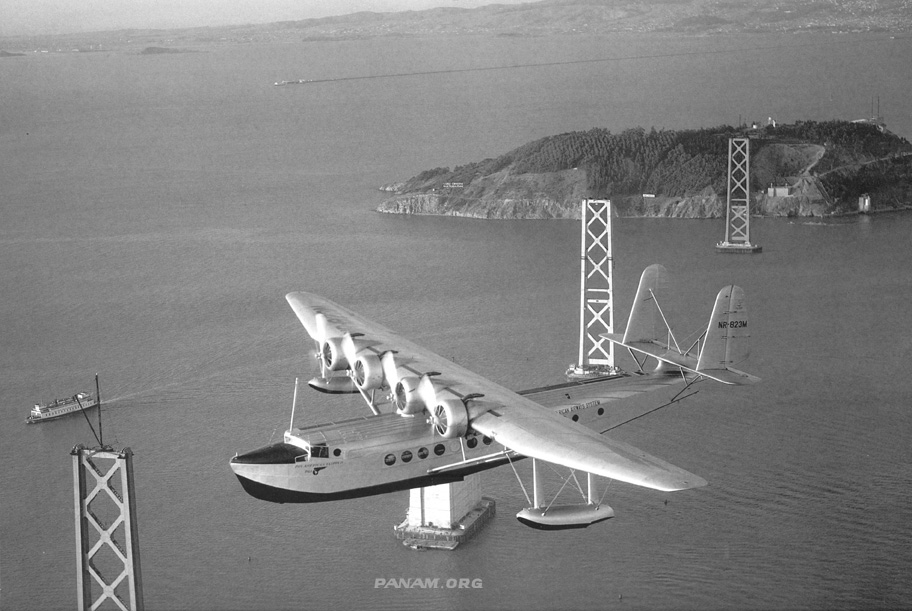
The Pan American Clipper, piloted by Capt Ed Musick on her first Pacific survey flight, April 1935, sister ship to the Samoan Clipper (Photo: Clyde Sunderland photographer, Pan Am Historical Foundation Collection)
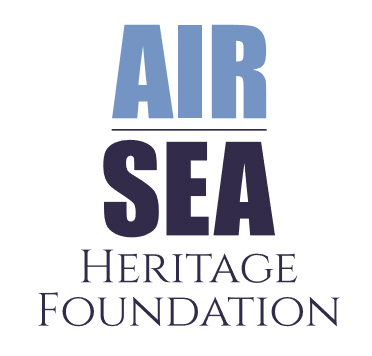


The Search for Samoan Clipper
by Russ Matthews, President and Co-founder, Air/Sea Heritage Foundation
We’re extremely pleased to share this article written for us by Russ Matthews, President and Co-founder of the Air/Sea Heritage Foundation, now working with Dr. Robert Ballard’s Ocean Exploration Trust to locate and document the site of the sunken Samoan Clipper.
This summer the Air/Sea Heritage Foundation will launch an expedition to locate, identify, and document the wreckage of Samoan Clipper (NC16734), a Pan American Airways Sikorsky S-42B flying boat that went down near Pago Pago, American Samoa, on 11 January 1938 with its entire crew, including the airline’s Chief Pilot, Edwin C. Musick. More than five years of research and planning has been devoted to the mission in collaboration with SEARCH, INC. and Ocean Exploration Trust (OET), with invaluable support from numerous other dedicated individuals and organizations, including the Pan Am Historical Foundation. If successful, the survey will characterize a site of major archaeological importance and determine the last resting place of seven aviation pioneers while collecting conclusive evidence as to what led to their fate.
The project will base out of Apia, Samoa and conduct search operations off the northwest coast of Tutuila Island (American Samoa) for six days aboard OET’s state-of-the-art science ship E/V Nautilus from 15-20 July 2019. Sonar and video data will stream directly from the ship via satellite, allowing anyone with an internet connection to follow the investigation in real time by logging onto http://www.nautiluslive.org
BACKGROUND
Beginning in the late 1920s, Pan American was at the forefront of an audacious effort to establish aerial links between the USA and the rest of the globe that would ultimately help to define the modern air transport industry. The most challenging and highly romanticized routes were those that stretched across the vast Pacific Ocean and the flying “Clippers” that plied them came to symbolize Aviation’s Golden Age.
The Samoan Clipper was built at the Sikorsky Aircraft factory in Bridgeport, Connecticut as the eighth of ten S-42 type flying boats sold exclusively to PAA and designed to swiftly carry 32 passengers over thousands of miles in unparalleled luxury. Serial number 4207 (as it was then known) would be the first of three S-42 aircraft modified as “B” models, given added fuel capacity and expanded crew facilities to make special long-range survey flights and open yet more new pathways. After delivery in 1936, she was assigned the federal registration number NC16734 and the next year was tasked to survey the route between the United States and New Zealand by way of Alameda, Honolulu, Kingman Reef, Pago Pago (American Samoa) and Auckland, under the command of Pan American’s legendary Chief Pilot, Edwin C. Musick.
For this first trial run from the USA to New Zealand and back in March and April of 1937, she carried the proud name Pan American Clipper II. Following that successful survey flight, the big Sikorsky was retrofitted as an airliner, rechristened Hong Kong Clipper, and transferred to fill the need for shuttle service between Manila and her new namesake home base at the far flung British outpost in China. December of that year would see NC16734 returned to its original long-range survey configuration and reassigned yet again. This time the well-traveled workhorse was chosen to inaugurate regular air mail flights between Auckland and the US territory of Hawaii, along the same route she had proven just eight months earlier. Pan Am’s master aviator Ed Musick stepped back onboard as pilot-in-command and the plane was redubbed with the appropriately region-specific title, Samoan Clipper.
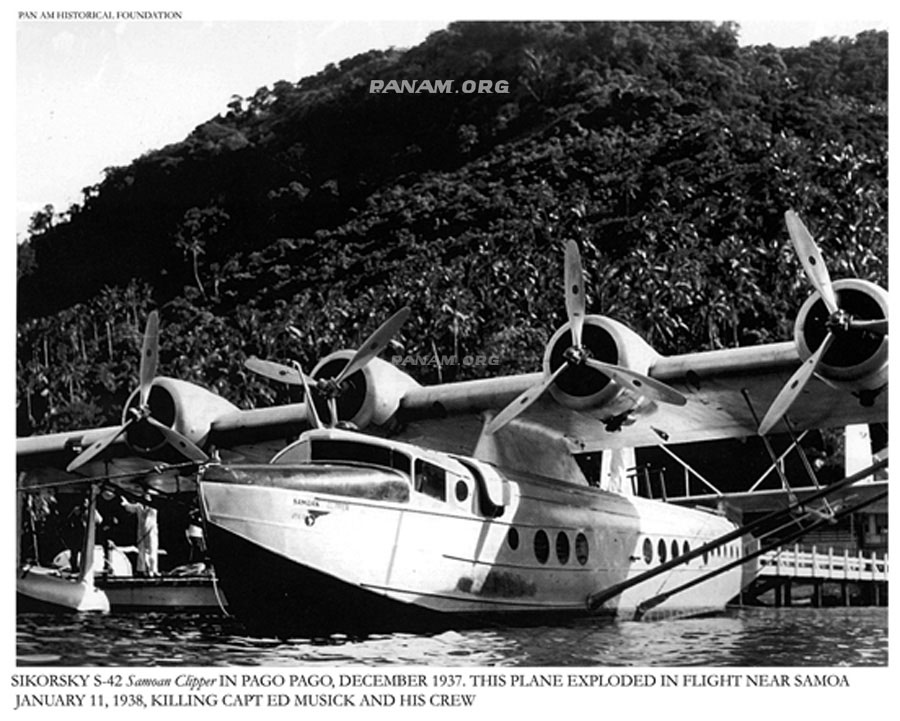
NC16734 Samoan Clipper at Pago Pago, 24 December 1937 (PAHF Collection)
Musick had been with Pan American from the very beginning when, as “pilot number 1” he flew the fledgling airline’s first scheduled air mail flight from Key West to Havana on 28 October 1927. He would go on to spearhead nearly all of Pan Am’s ever-expanding routes to the Caribbean, Latin America and the Pacific. At one time, Musick held more records and honors than any other active flier, including the 1935 Harmon Trophy which recognized him as “the world’s outstanding aviator.” Thoroughly professional and scrupulously careful with the souls and planes under his care, “Uncle Ed” earned the everlasting respect of his peers as the ideal model of a transport pilot.
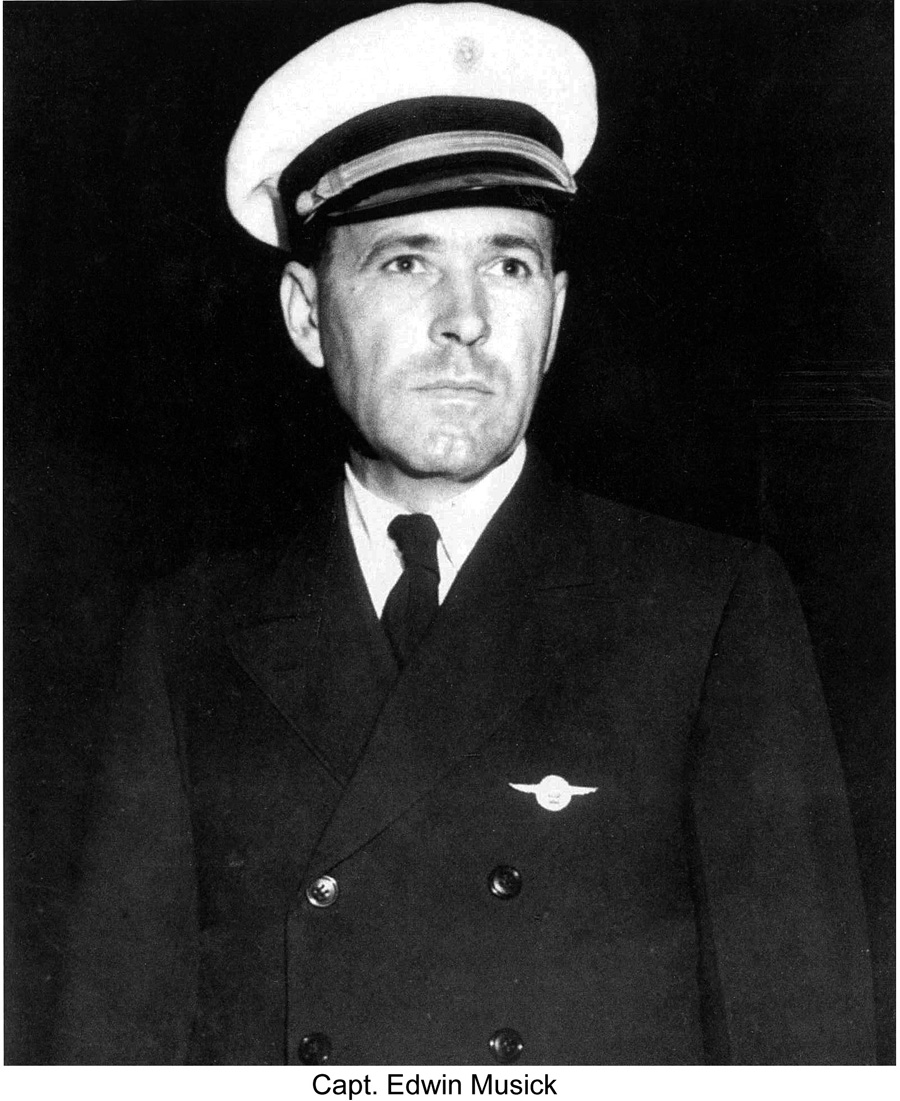 Ed Musick in 1935 (Pan Am Historical Foundation Collection)
Ed Musick in 1935 (Pan Am Historical Foundation Collection)
On 23 December 1937, Musick and his crew set out from Pearl City, Oahu on what would be Pan Am’s second round trip from the USA to New Zealand, a critical first stage in securing vital government contracts that called for air mail service between the two countries to begin before the end of the year. Landing at Auckland on 26 December 1937, the Pan American aviators were warmly received by cheering crowds of enthusiastic Kiwis, who lined the shore in their thousands. The momentous arrival of Samoan Clipper coincided with a near simultaneous appearance by the British flying boat Centaurus, there to commence Imperial Airways’ service to the isolated Commonwealth nation from the opposite side of the globe. A week later, Musick and his crew began the new year by tackling the difficult return flight to Hawaii, again trusting their skill and their aircraft to carry them safely home, arriving (across the International Date Line) on 3 January 1938.
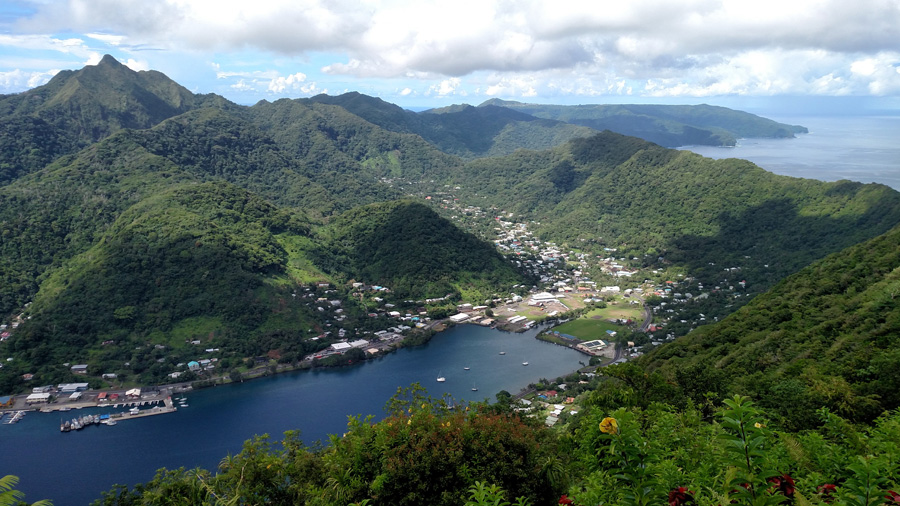 Pago Pago Harbor taken from the top of Mt. ‘Alava facing W/NW. You can see the narrow landing area for the clipper in the foreground and the high ridge Capt. Musick needed to clear before landing is to the right. (Photo: Russ Matthews)
Pago Pago Harbor taken from the top of Mt. ‘Alava facing W/NW. You can see the narrow landing area for the clipper in the foreground and the high ridge Capt. Musick needed to clear before landing is to the right. (Photo: Russ Matthews)
After only six days of rest the Samoan Clipper was prepped for a repeat performance on the long and demanding run to Auckland via tiny Kingman Reef and Pago Pago’s daunting mountain-ringed harbor. This accelerated schedule was deemed essential in order to complete the roundtrip express mail run from New Zealand and lay firm claim to that important contract. The first two legs passed uneventfully and the morning of 11 January 1938 saw Samoan Clipper shove off from the Pan Am dock at Pago Pago, where at 05:32 (local time) Musick throttled up and lifted off for the final, fateful leg of this third outbound journey Down Under.
The first sign of trouble came an hour into the flight when “NC34” (as the Pan Am radio operators would note it) reported an oil leak in the Number 4 engine. Musick declared he had elected to shut down the balky motor and return to American Samoa. At 07:59 the plane was sighted over Apia (in what was then the New Zealand-administered trust territory of Western Samoa) and headed in the direction of Tutuila (the main island of American Samoa) 75 miles away. Another radio contact was received starting at 08:27 informing the PAA station that Musick would be dumping fuel to lighten his now underpowered and still heavily laden ship before attempting to land in the severely restricted waters of Pago Pago harbor just a short distance ahead.
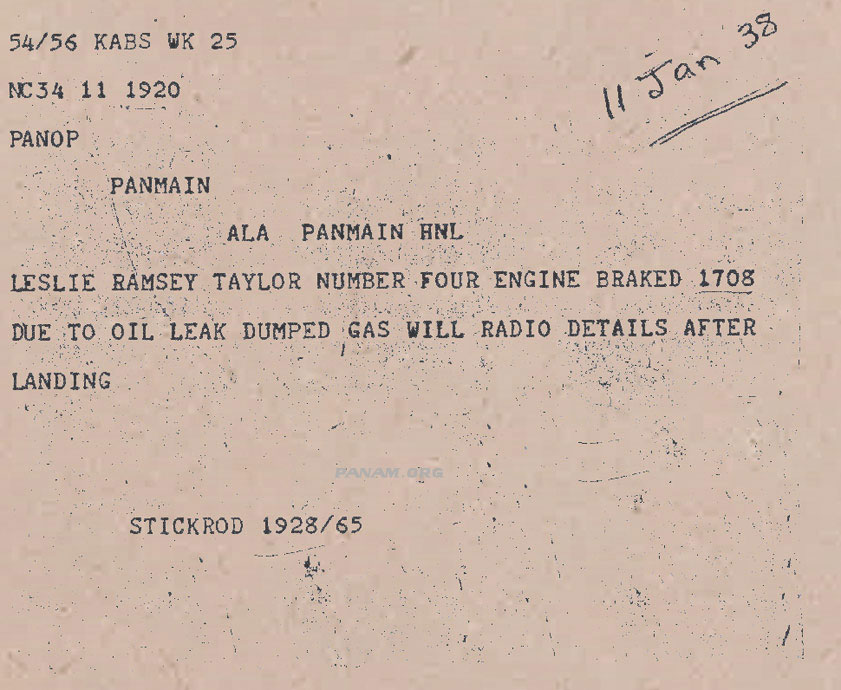
The last message from the Samoan Clipper (Courtesy Taylor Collection, Pan Am Historical Foundation)
After 08:35 all contact was lost with Samoan Clipper and her crew.
Audio file: Loss of Samoan Clipper
THE SEARCH
Within hours, reports reached Pago Pago that “native fishermen” had spotted smoke off the NW coast of the island. A US Navy plane was dispatched to search the area and quickly sighted an oil slick that “appeared to be coming from [the] ocean floor.” The minesweeper/seaplane tender USS Avocet (AVP-4) sailed from Pago Pago and was vectored to the scene some “12 miles north of Tapu Tapu Point” (the western-most tip of Tutuila Island).
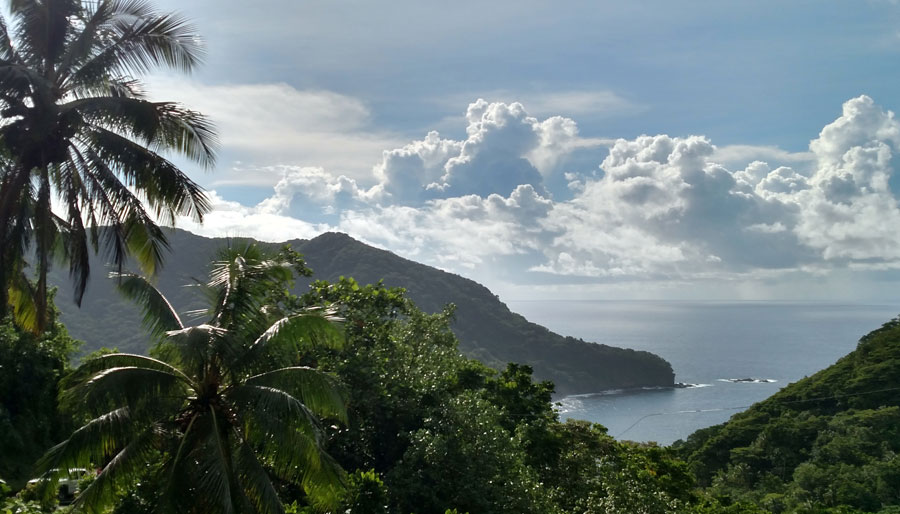 Fagasa Bay. The last sighting of the Samoan Clipper was made just offshore from here, where a witness saw the plane flying low in the “direction of Apia” (East to west .. or right to left here), trailing fuel before turning out to sea and diving for the water. (Photo: Russ Matthews)
Fagasa Bay. The last sighting of the Samoan Clipper was made just offshore from here, where a witness saw the plane flying low in the “direction of Apia” (East to west .. or right to left here), trailing fuel before turning out to sea and diving for the water. (Photo: Russ Matthews)
Shortly after first light on 12 January, Avocet’s crew spotted the tell-tale sheen of fuel mixed with assorted debris floating on the surface. A ship’s boat was launched to collect what they could. Recovered items comprised mainly small, charred pieces of “flooring, partitioning, books, papers, interior wall parts and the navigator’s drift target tray.” Most telling and heartbreaking of all was a tattered Pan American Airways officer’s jacket with its distinctive winged “PAA” logo identified as belonging to Samoan Clipper’s radio officer, T.J. Findley.
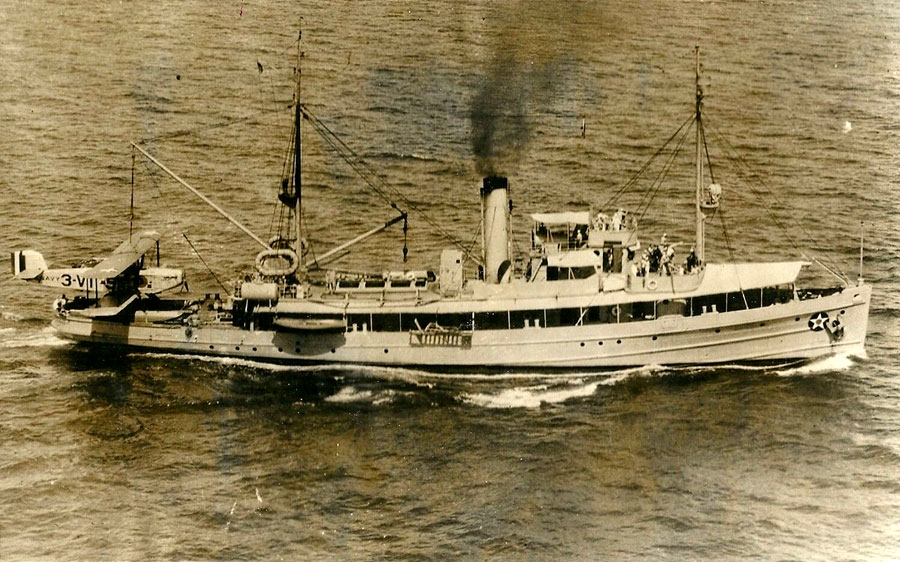 The USS Avocet (AVP-4) was on the scene the following day (Photo courtesy Air/Sea Heritage Foundation)
The USS Avocet (AVP-4) was on the scene the following day (Photo courtesy Air/Sea Heritage Foundation)
The position of these finds was recorded and preserved in a Bureau of Air Commerce accident report (dated 1 April 1938) that concluded the loss of the Samoan Clipper was probably due to “fire and explosion associated with the dumping of fuel, the precise cause of ignition being undeterminable.” Speculation focused on a static charge, engine exhaust or a spark from the electrically driven flap actuators as they were engaged prior to landing, but without an opportunity to closely examine the main body of wreckage, the exact reason for the destruction of NC16734 was reluctantly left a mystery.
In the days following the accident, inquiries were made with an eye toward recovering the plane and her crew. Divers were considered as well as an idea to drag for the wreckage from a US Navy cruiser or perhaps hiring a cable laying/repair vessel for the task. However, soundings taken in the area showed water depth at the wreck site to be “1,000 fathoms,” placing Samoan Clipper far beyond the reach of any technology available at that time.
Today’s searchers will greatly benefit from these diligent efforts made eighty-one years ago, combined with the current generation of undersea search tools which has now opened access to these deep waters like never before. It may at last be possible to write the final chapter of the Samoan Clipper story.
THE PROJECT
A renewed search for Samoan Clipper began in early 2014 with a white paper coauthored by Russ Matthews (President and Co-founder of Air/Sea Heritage Foundation), noted maritime archaeologist Dr. James Delgado, and aviation historian Lonnie Schorer. The study was presented in December of that year at a workshop “for the purpose of identifying and discussing potential targets for telepresence-enabled exploration in the eastern Pacific Ocean” that was hosted by NOAA along with the Ocean Exploration Trust (OET) and its President/Founder, Dr. Robert Ballard (who is perhaps most widely known as the man who found the Titanic, Bismarck, Yorktown and numerous other historic wrecks). Samoan Clipper emerged from this expert gathering rated as “a high priority for exploration.”
Accordingly, Russ Matthews continued to delve into the mystery of Musick’s untimely end and designated the search for Samoan Clipper as an official project of the Air/Sea Heritage Foundation. By mid-2018 it seemed the time had come to prepare concrete plans outlining the steps necessary to find the wreck. Dr. Delgado, now with the international private survey firm SEARCH, INC recruited another colleague and friend, archaeologist Dr. Michael Brennan, to take up the challenge. Brennan was especially well suited to the task having previously served as Director of Maritime Archaeology and Maritime History for Ocean Exploration Trust before joining SEARCH, INC. In fact, all three men had worked and sailed together before during an August 2016 joint OET/NOAA mission aboard E/V Nautilus which first explored and identified the wreck of USS Independence (CVL-22), a WWII era aircraft carrier scuttled off the coast of Northern California. The Samoan Clipper search team soon had a detailed proposal in hand with a good chance of locating the lost plane, provided a suitable expedition vessel could be found and brought to the northwest shore of Tutuila.
THE EXPEDITION
They would not have long to wait. Word came in November 2018 that an ideal ship, laden with high tech subsea search equipment and staffed with an experienced, expert crew was already scheduled to work in Samoan waters for several weeks in the following summer. As fate would have it, that ship proved to be none other than E/V Nautilus, the 211 foot (64 meter) long exploration vessel owned and operated by Ocean Exploration Trust.
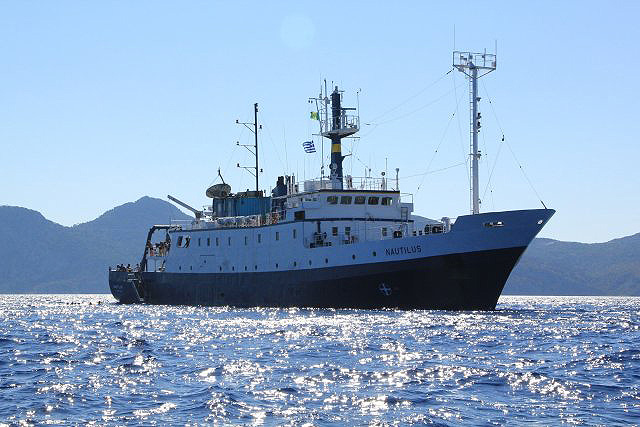 The E/V Nautilus will be on the scene to conduct the search for Samoan Clipper in July. (Courtesy Ocean Exploration Trust)
The E/V Nautilus will be on the scene to conduct the search for Samoan Clipper in July. (Courtesy Ocean Exploration Trust)
The ship is equipped with a Kongsberg EM302 multibeam sonar, dynamic positioning, A-frame and winch, plus the versatile Hercules/Argus dual ROV system. Nautilus typically runs 24/7 operations to maximize time at sea, and features a satellite-linked telepresence system capable of streaming real time video and audio to the OET website (www.nautiluslive.org) where the general public may follow the investigation and even interact with the on board science team from shore.
Seizing on this rare bit of serendipity placing the perfect assets in exactly the right place, Russ Matthews and Air/Sea Heritage Foundation signed a contract (dated 11 January 2019, the 81st anniversary of Samoan Clipper’s loss) with OET to charter E/V Nautilus for the search. Everyone involved was well pleased to see the project come full circle in the five year span from the initial workshop to the upcoming field season with all of the original participants in place.
See a time-lapse video of “Argus,” the towed submersible camera/lighting/sonar platform being launched from E/V Nautilus, along with “Hercules,” a remotely operated vehicle (ROV). Together, these submersibles work in tandem to explore and record underwater sites, even at great depths.
Trouble viewing? Link to https://www.youtube.com/watch?v=g1w2jinW8u0
Plans call for a survey in the area of the reported crash site utilizing a towed EdgeTech 4200 MP 600/300 kHz side-scan sonar mounted on the Argus rig. When promising targets are acquired, an ROV will be lowered to get visual of confirmation of the seabed anomalies with HD video cameras. In the event Samoan Clipper is located and identified, OET’s Argus/Hercules system will be employed to thoroughly investigate and document the wreck. The first priorities will be to determine the full extent of the site, plot the relative position of all components and capture high definition photographic/video imagery of everything (with particular emphasis on those identifying features and markings unique to NC16734).
Special effort will be made to gather new evidence on the root causes of the 1938 explosion and crash. The team wants to examine the right outboard (Number 4) engine that was shut down, necessitating a return to Pago Pago. Likewise, the wing tank dump valves will demand close attention, along with the engine exhaust, electric flap actuators and fuel pump, looking for signs of scorching or other clues as to the ultimate source of ignition. Air/Sea Heritage Foundation is working to recruit a diverse group of historians, aircraft restoration specialists, accident investigators, and aviation advocates. This cadre of experts will serve as “on call” advisors, linked to the field team via telepresence and able to contribute their singular insights as needed from virtually anywhere around the globe.
All involved in this project remain mindful of the human cost associated with the downing of Samoan Clipper. If the wreck can be found, it is hoped this may bring some closure to the extended families of the lost fliers by paying tribute to the sacrifices they made in forging links between once distant people and countries through aviation. Sharing the full story of Samoan Clipper may also yet inspire new generations to explore their world, whether through the air or beneath the sea.
RELATED ARTICLES
> Samoan Clipper UPDATES: July 2019 Air/Sea Heritage Foundation Search
> A Pan Am Great - Captain Edwin Musick
